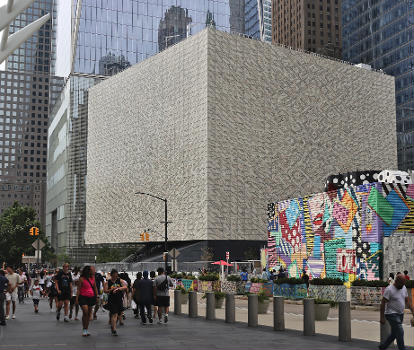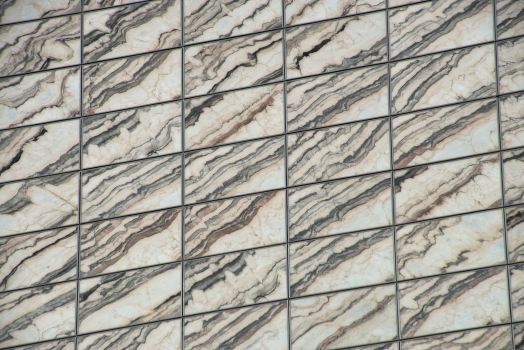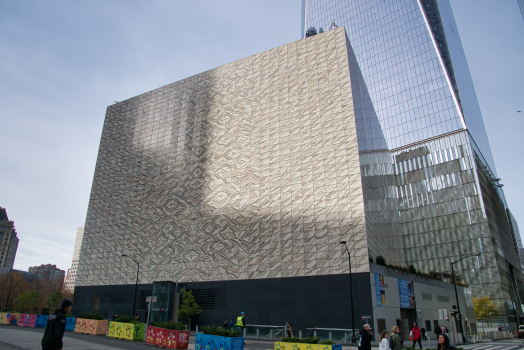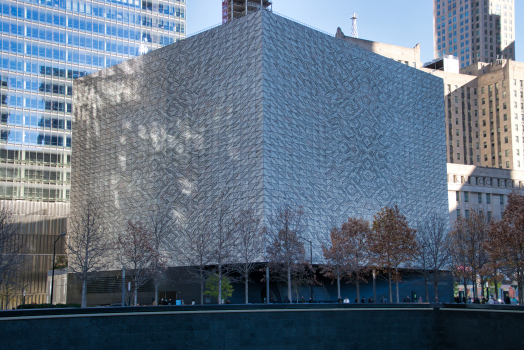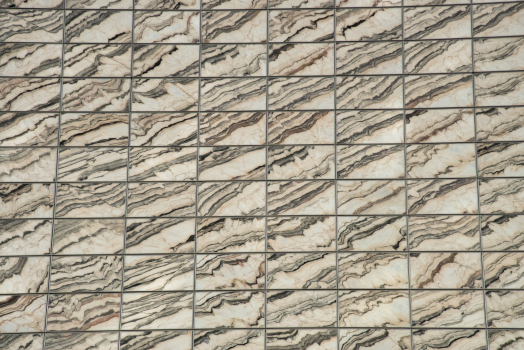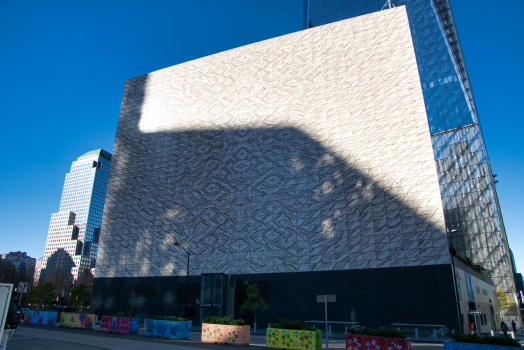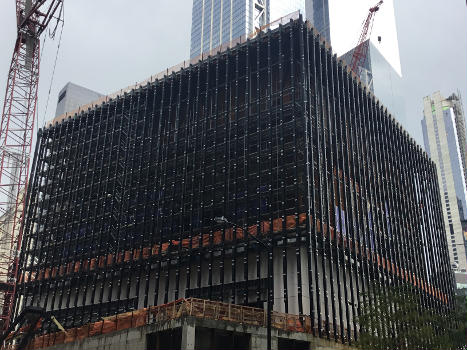General Information
Project Type
| Function / usage: |
Cultural center |
|---|---|
| Material: |
Steel structure |
Location
Technical Information
Dimensions
| height | 42 m |
Cost
| cost of construction | United States dollar 275 000 000 |
Architect's Design Narrative
On the most significant site in New York City, the Ronald O. Perelman Performing Arts Center at the World Trade Center (The Perelman Center) will premiere works of theater, dance, music, film, and opera, transforming Lower Manhattan into a vibrant, global cultural heart. The design is inspired by The Perelman Center’s mission to defy experiential expectations. Its concept embodies the Center’s aim to foster artistic risk, original local productions, and worldwide collaborations; stand as the most technologically connected and advanced venue in the world, and engage the local community. The keystone and final piece of the World Trade Center master plan, The Perelman Center embraces creation and memory with respectful individuality.
The Rough in a Diamond
Amidst gleaming glass towers on the north side of the 9/11 Memorial, The Perelman Center is a pure form, rotated and elevated to accommodate complex below-grade constraints, address the 9/11 Museum and transportation hub, and engage the site’s main pedestrian streets of Greenwich and Fulton. The edifice is wrapped in translucent, veined marble—from the same Vermont quarry as the U.S. Supreme Court building and the Thomas Jefferson Memorial— laminated within insulated glass. By day, the volume is an elegant, book-matched stone edifice, whose simplicity and traditional material acknowledge the solemnity of its context. Daylight illuminates the interior through the marble façade. By night, this monolith dematerializes: silhouettes of human movement and theatrical configurations animate the glowing enclosure, an invitingly subtle revelation of the creative energy inside.
While the building’s pristine exterior befits the site, its muscular, utilitarian interior expresses the workhorse quality necessary for the changing nature of The Perelman Center’s artistic needs. Steel walls, concrete trusses, wood floors, perforated plywood panels, and other ruggedly beautiful materials encourage the frequent transformation of scenery, stage-audience configurations, and even the restaurant/bar and lobby. The building’s material duality—elegant exterior and robust interior—forms ‘The Rough in a Diamond.’
Multi-Form, Multi-Procession, and Experiential Surprise: The Play Level
The Perelman Center is organized in three levels—Public (bottom), Performer (middle), and Play (top). The layout and character of the Play Level drive the design of the entire building.
The Play Level is a pioneering, highly adaptable performance palette that combines both multi-form and multi-processional flexibility. It holds three auditoria (499-, 250-, and 99-person) and a rehearsal room which can double as a fourth venue. Using large, acoustic, guillotine walls that separate them, the three auditoria can be combined to form seven additional, unique performance spaces for a total of eleven arrangements—including the rehearsal room venue—which can all adopt manifold stage-audience configurations. On the perimeters of the rehearsal room and the 250- and 99- person auditoria, acoustic glass walls with integrated black-out blinds provide natural light into performances and rehearsals, and enable these rooms to be rented for events.
Directors can further choreograph the audience’s entire experience through a zone of mutability around the auditoria. Acoustic doors between scene docks, scene assemblies, and a circulation loop at the floor’s periphery allow directors to apportion any of these areas as front- or back-of-house, and to form unexpected lobbies and performance ante-chambers. Also, the key to these permutations, baffles pivoting from the auditoria’s exterior walls can function as traffic valves to direct the audience into or past an auditorium’s entrance, or block access to anyone but performers. And finally, the four elevator/stair couplets can be used individually or in combination, creating unexpected access sequences from the lobby to the auditoria in any of their varied formations.
As a result of this immense flexibility, the Play Level is a constant source of surprise for patrons, a ‘Mystery Box’ whose experiences are scripted entirely by each director’s imagination.
Direct Access and Inspiring Environment: The Performer Level
Right below the Play Level, the Performer Level contains all support areas for performances and artists, such as trap, dressing rooms, green room, musician room, quiet room, wig storage, and costume shop. Artists have direct, private access to the Play Level via a dedicated elevator/stair couplet, or—if blurring the line between performer and patron is desired—the other three public couplets. Unlike most performance venues which place performer and other back-of-house areas below grade, artists are at the core of The Perelman Center, with generous accommodations and daylight filtered through the ‘stone-glass’ façade.
Restaurant/Bar, Informal Stage, and Community Living Room: The Public Level
In contrast to the ticketed areas of the Play Level and the secure areas of the Performer Level, the functions of the Public Level can be enjoyed by anyone, anytime. This floor includes a lobby with an information desk and coat check, and a restaurant/bar that can transform into a cabaret, a dance podium, a performance art space, or a ‘living room’ for Lower Manhattan community events such as voting. The restaurant/bar—used for refreshments during performance intermissions—extends north to an exterior terrace with views over the new sculpture garden nestled between The Perelman Center and World Trade Center Tower 1.
The Perelman Center’s exterior staircase brings theater patrons and visitors from the lobby back down to the street below. Half this grand stair offers generous seating for people who want to linger, watch the bustling city around, or contemplate the beautiful memorial across Fulton Street.
With its artistic freedom, openness to the community, pure form, and material duality, The Perelman Center galvanizes the culture of New York City’s lower downtown and asserts its place amongst the World Trade Center’s constellation of world-class buildings.
Excerpt from Wikipedia
The Perelman Performing Arts Center, branded as PAC NYC, is a multi-space performing arts center at the northeast corner of the World Trade Center complex in Manhattan, New York City. The Performing Arts Center is located at the intersection of Vesey, Fulton, and Greenwich Streets in Lower Manhattan. The building is named for billionaire Ronald Perelman, who donated $75 million to its construction.
Plans for the Performing Arts Center were first announced by the Lower Manhattan Development Corporation (LMDC) in 2004 as part of the rebuilding of the World Trade Center site after the September 11 attacks. Gehry Partners LLP and Snøhetta were selected as the original designers, but plans were repeatedly stalled and later scrapped. Joshua Ramus and Davis Brody Bond were selected as architects in 2015, joined by Magnusson Klemencic Associates (MKA) as the structural engineer. Below-ground construction began in August 2017, followed by the construction of the above-ground frame in 2020. The center, known during construction as the Ronald O. Perelman Performing Arts Center at the World Trade Center, opened on September 13, 2023. The Performing Arts Center includes approximately 90,000 square feet (8,400 m²) across three floors.
Development
Original design
After the World Trade Center was destroyed during the September 11 attacks in 2001, officials sought to redevelop the site. Daniel Libeskind's 2003 design for the new World Trade Center, known as Memory Foundations, included space for a performing arts center at the site. The Lower Manhattan Development Corporation (LMDC) announced on October 12, 2004, that Gehry Partners LLP and Snøhetta, an architectural firm from Norway, would design the Performing Arts Center. Gehry's proposal, which incorporated a boxlike design, would have housed the Joyce Theater, as the Signature Theatre Company had dropped out due to space constraints and cost limitations. Then-mayor Michael Bloomberg announced in 2010 that he would provide $100 million for the theater's construction from a federal fund dedicated to projects in Lower Manhattan.
Maggie Boepple was appointed as the Performing Arts Center's president in March 2012. Plans for the construction of the Performing Arts Center were reportedly stalled over financing and design, although construction was also hindered by the presence of the entrance to the PATH train's temporary World Trade Center station within its footprint. In February 2014, David Lan, artistic director of London's Young Vic Theatre, was announced as consulting artistic director of the Performing Arts Center, a position he was to hold simultaneously with his Young Vic leadership. The venue's mission was revised to originate works of theater, music, and dance in three small flexible theaters.
Redesign
Performing Arts Center design as of 2015
By September 2014, Gehry Associates were no longer connected with the project. Plans were proceeding for the choice of a new architect and future programming for a 2019 opening. Gehry's design was scrapped; the board of the Performing Arts Center planned to choose a new design from one of three other architects. This change came after Boepple was said to have disapproved of Gehry's work.
In July 2015, it was reported that the construction budget for the Performing Arts Center was to be reduced from $350 million to $200 million. The Lower Manhattan Development Corporation (LMDC) announced at a board meeting that the $99 million in federal funds committed to the project was contingent on the arts center's leaders' "producing an affordable design and a viable plan for raising the remaining money from private sources." In November 2015, the Performing Arts Center announced that they had awarded the design architect contract to Joshua Ramus of REX, with the firm Davis Brody Bond serving as executive architect.
On March 3, 2016, the permanent PATH station building opened one block to the south, and the temporary entrance was closed. The opening of the new station building allowed the temporary station entrance to be demolished in August of that year. This, in turn, allowed the construction of the Performing Arts Center on the site.
On June 29, 2016, billionaire Ronald Perelman donated $75 million to the construction and endowment of the Performing Arts Center at the World Trade Center. The donation funded part of the Performing Arts Center's construction, as well as provided an endowment and funded the operations. The center was renamed for Perelman. The project also received $130 million from Michael Bloomberg (although this was not disclosed until 2023) and had previously obtained $100 million from the LMDC. In September 2016, Barbra Streisand was named the chairwoman of the center's board. The concept art for the new building was revealed that month, with mostly positive reviews from architecture critics. On March 27, 2017, it was announced that construction would be delayed due to ongoing disputes between the Lower Manhattan Development Corporation (LMDC) and the Port Authority regarding funding for the project.
Construction
Preliminary site plans for the World Trade Center rebuild Construction on the Performing Arts Center in June 2021
Construction began in August 2017 on its below-grade parking garage, which will be accessible from the rear of the building on Vesey Street. Work on the building itself was originally expected to begin in 2018, with an estimated 2020 completion date and opening. The Port Authority gave the Performing Arts Center a 99-year lease in February 2018, and Bill Rauch was appointed as the new artistic director. The first pieces of structural steel arrived that April. Work was halted in early 2018 due to financial disagreements between the Port Authority and LMDC, but routine steel work and concrete pouring resumed shortly thereafter. The Performing Arts Center received $89 million from the LMDC and the United States Department of Housing and Urban Development in December 2018.
Underground work was completed in July 2019, and steel construction began later that year. Leslie Koch was also named as the president of the Perelman Performing Arts Center that year, replacing Boepple. At the time, the Performing Arts Center was scheduled to open in 2021. The lead designer described the venue as resembling "multiple buildings being constructed inside the building—because it was". The building topped out on September 11, 2020, the 19th anniversary of the September 11 attacks. Khady Kamara of Second Stage Theater was appointed in October 2022 as the center's executive director.
Opening and operation
Construction manager Sciame Construction conducted various tests and installed finishes on the center in mid-2023, in advance of a scheduled opening on September 15, 2023. A ribbon-cutting ceremony for the Perelman Performing Arts Center was hosted on September 13, 2023, two days ahead of schedule. The first public performance was scheduled for September 19. The venue had cost $560 million in total. Kamara stated that her mission was to convince visitors to travel to the World Trade Center for entertainment purposes. The center, branded as PAC NYC, planned to host dance, film, music concerts, opera, and theatrical productions. The Metropolis restaurant, operated by Marcus Samuelsson, opened at the Performing Arts Center in November 2023. Joseph Lebus also created a special typeface and a square logo as part of PAC NYC's brand.
During its initial season in 2023–2024, PAC NYC hosted performances such as Trinity Church Wall Street's concert series Refuge; a piano recital by Mahani Teave; and Tamar-kali and Marc Bamuthi Joseph's opera Watch Night.
Architecture
The Perelman Performing Arts Center was designed by main architect REX, executive architect Davis Brody Bond, acoustic consultant Threshold Acoustics, and theatrical consultant Charcoalblue. The structural engineers on the project include Magnusson Klemencic Associates and Robert Silman Associates; the MEP, fire protection, IT and security engineer is Jaros, Baum & Bolles; and the construction manager is Sciame Construction, LLC. Other key contributors to the project team include David Rockwell's Rockwell Group, architect of the restaurant and lobby interiors; Charcoalblue, theater designer; and Tillotson Design Associates, architectural lighting designer.
Exterior
The Performing Arts Center measures 160 by 160 feet (49 by 49 m) across and 117 feet (36 m) tall, resting upon a black-granite pedestal that measures 21 feet (6.4 m) tall. The building's facade consists of 5,000 panels of veined Portuguese marble. The panels contain lozenge-shaped patterns and turn an amber color at night. The stone on the facade measures 0.5 inches (12.7 mm) thick and is covered in glass on both sides to reduce energy use and increase security. There are no windows on the facade; according to Ramus, this "keeps the buzz of theatergoers at a respectful distance from people who are paying tribute at the memorial, and vice versa". Just inside the facade, a corridor runs around the Performing Arts Center's auditoriums, with chandeliers that backlight the facade at night.
Interior
The venue includes 129,000 square feet (12,000 m²) across three floors. The Performing Arts Center rests upon the footings of the first, unbuilt performing arts venue on the site. Due to the complexity of the infrastructure under the Performing Arts Center, the structure is connected to its foundations at only seven locations. The public floor is located at street level and houses a restaurant/bar to provide refreshments during intermissions. The second floor consists of rehearsal and dressing rooms for theater actors, and the third floor houses three theaters. The largest auditorium, named after businessman John Eugene Zuccotti, has 450 seats. Another auditorium named for director Mike Nichols has 250 seats, while the smallest space, named for philanthropist Doris Duke, has 99 seats.
All three theaters are designed so that the walls will be able to rotate and expand to provide extra space for a single theater if needed. The theaters can hold approximately 1,000 or 1,200 people combined. To reduce vibrations from nearby subway lines, the three theaters are separated from each other and from nearby structures by 1-foot-thick (0.30 m) pads. The floor and ceiling heights can also be modified, The auditoriums can be arranged in at least 60 configurations and can also be combined into a single space with 950 seats. The "guillotine doors" between each auditorium measure up to 46 short tons (41 long tons; 42 t) and can retract into mechanical spaces above each auditorium.
Operation
Since 2022, Khady Kamara has been PAC NYC's executive director. Former mayor Michael Bloomberg is the chairman of PAC NYC's board of directors, while Bill Rauch is the artistic director. PAC NYC's inaugural artistic advisers included Murielle Borst-Tarrant, Ty Defoe, Wendall Harrington, David Henry Hwang, Lisa Kron, David Lan, Joe Melillo, Nico Muhly, Lynn Nottage, Arturo O'Farrill, Jason Samuels Smith, Sonya Tayeh, Julie Taymor, Ivo van Hove, Alexandria Wailes, and Jawole Willa Jo Zollar.
Reception
When the Performing Arts Center was completed, architectural critic Justin Davidson described the structure as holding "the spotlight on a highly visible stage, offering spectacle without garishness". Peter Marks of The Washington Post wrote: "The windowless, marble-clad structure sits on the Ground Zero site like a giant sugar cube. Or more aptly, perhaps, like one in a pair of massive stone dice." According to The New York Observer, "The Perelman, in all its grandeur, is more than just a venue—it's a beacon of potential, further amplifying New York's prominence in the global arts scene and standing as Manhattan's fresh fountain of creativity."
The Performing Arts Center has received multiple design awards, including the Society of Registered American Architects New York, Special Award for Innovation in Cultural Architecture, 2022; American Institute of Architects New York, Honor Award in Projects, 2022; The Chicago Athenaeum American Architectural Award, 2021; Architizer A+ Awards, Winner in the Unbuilt Cultural Category, 2019.
Text imported from Wikipedia article "Perelman Performing Arts Center" and modified on September 3, 2024 according to the CC-BY-SA 4.0 International license.
Participants
-
REX
- Joshua Prince-Ramus (architect)
Relevant Web Sites
Relevant Publications
- (2024): Wirklich nur ein Würfel? Fassade des Ronald O. Perelman Centers of Performing Arts in New York. In: Stahlbau, v. 93, n. 6 (June 2024), pp. 379-389.
- About this
data sheet - Structure-ID
20010235 - Published on:
07/09/2003 - Last updated on:
23/11/2024

